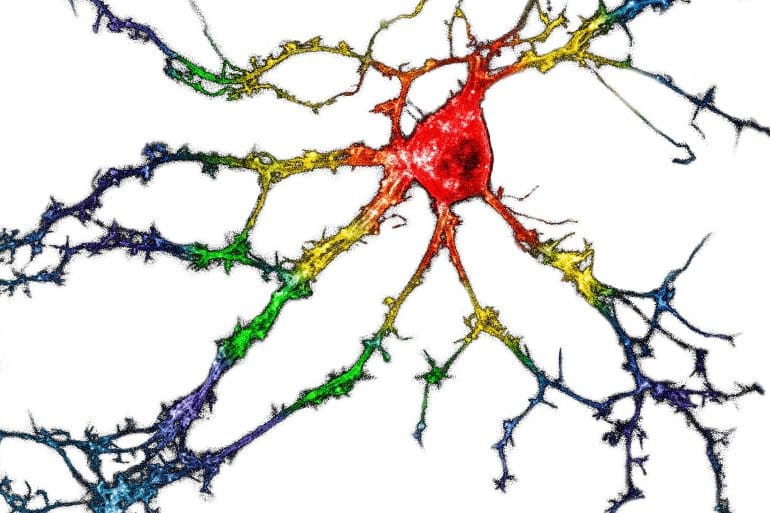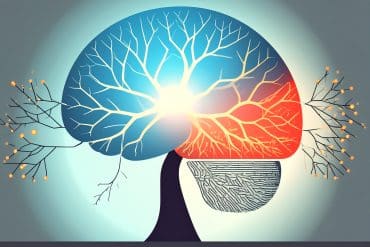Summary: PsychLight, a newly developed genetically encoded fluorescent sensor, helped researchers identify a psychedelic compound that acts on beneficial neural pathways to treat psychiatric disorders without the hallucinogenic effect.
Source: Cell
Psychedelic drugs have shown promise for treating neuropsychiatric disorders such as depression and posttraumatic stress disorder. However, due to their hallucinatory side effects, some researchers are trying to identify drugs that could offer the benefits of psychedelics without causing hallucinations.
In the journal Cell on April 28, researchers report they have identified one such drug through the development of a genetically encoded fluorescent sensor–called psychLight–that can screen for hallucinogenic potential by indicating when a compound activates the serotonin 2A receptor.
“Serotonin reuptake inhibitors have long been used for treating depression, but we don’t know much about their mechanism. It’s like a black box,” says senior author Lin Tian, an associate professor in the Department of Biochemistry and Molecular Medicine in the School of Medicine at the University of California, Davis.
“This sensor allows us to image serotonin dynamics in real time when animals learn or are stressed and visualize the interaction between the compound of interest and the receptor in real time.”
Tian’s lab joined forces with the lab of David E. Olson, an assistant professor in the Department of Chemistry at UC Davis, whose lab is focused on drug discovery.
“This paper was an exceptionally collaborative effort,” says Olson, a co-author on the study.
“My lab is really interested in the serotonin 2A receptor, which is the target of both psychedelic drugs and classic antipsychotics. Lin’s lab is a leader in developing sensors for neuromodulators like serotonin. It just made perfect sense for us to tackle this problem together.”
Experts believe that one of the benefits of using psychedelic drugs over existing drugs is that they appear to promote neural plasticity–essentially allowing the brain to rewire itself.
If proven effective, this approach could lead to a drug that works in a single dose or a small number of doses, rather than having to be taken indefinitely. But one thing that researchers don’t know is whether patients would be able to gain the full benefit of neural plasticity without undergoing the “psychedelic trip” part of the treatment.

In the paper, the investigators report that they used psychLight to identify a compound called AAZ-A-154, a previously unstudied molecule that has the potential to act on beneficial pathways in the brain without hallucinogenic effects.
“One of the problems with psychedelic therapies is that they require close guidance and supervision from a medical team,” Olson says.
“A drug that doesn’t cause hallucinations could be taken at home.”
The serotonin 2A receptor, also known as 5-HT2AR, belongs to a class of receptors called G protein-coupled receptors (GPCRs). “More than one-third of all FDA-approved drugs target GPCRs, so this sensor technology has broad implications for drug development,” Tian says.
“The special funding mechanisms of BRAIN Initiative from the National Institutes of Health allowed us to take a risky and radical approach to developing this technology, which could open the door to discovering better drugs without side effects and studying neurochemical signaling in the brain.”
Funding: This work was supported by the National Institutes of Health, a Hellman Fellowship, and UC Davis STAIR and STAIR Plus grants.
Olson is the president and chief scientific officer of Delix Therapeutics, Inc., which is developing AAZ-A-154. Tian is a co-founder of Seven Biosciences, which is developing a GPCR-based imaging platform. That company was founded by Grace Mizuno, a previous graduate student in the lab.
About this neuropharamcology research news
Source: Cell
Contact: Carly Britton – Cell
Image: The image is credited to Calvin Ly
Original Research: Closed access.
“Psychedelic-inspired drug discovery using an engineered biosensor” by Lin Tian et al. Cell
Abstract
Psychedelic-inspired drug discovery using an engineered biosensor
Highlights
- •Engineered psychLight—a genetically encoded 5-HT sensor based on the 5-HT2AR
- •PsychLight can measure 5-HT dynamics in behaving mice
- •A psychLight-based cellular imaging platform predicts hallucinogenic potential
- •Identified a non-hallucinogenic psychedelic analog with antidepressant properties
Summary
Ligands can induce G protein-coupled receptors (GPCRs) to adopt a myriad of conformations, many of which play critical roles in determining the activation of specific signaling cascades associated with distinct functional and behavioral consequences.
For example, the 5-hydroxytryptamine 2A receptor (5-HT2AR) is the target of classic hallucinogens, atypical antipsychotics, and psychoplastogens. However, currently available methods are inadequate for directly assessing 5-HT2AR conformation both in vitro and in vivo.
Here, we developed psychLight, a genetically encoded fluorescent sensor based on the 5-HT2AR structure. PsychLight detects behaviorally relevant serotonin release and correctly predicts the hallucinogenic behavioral effects of structurally similar 5-HT2AR ligands.
We further used psychLight to identify a non-hallucinogenic psychedelic analog, which produced rapid-onset and long-lasting antidepressant-like effects after a single administration.
The advent of psychLight will enable in vivo detection of serotonin dynamics, early identification of designer drugs of abuse, and the development of 5-HT2AR-dependent non-hallucinogenic therapeutics.






